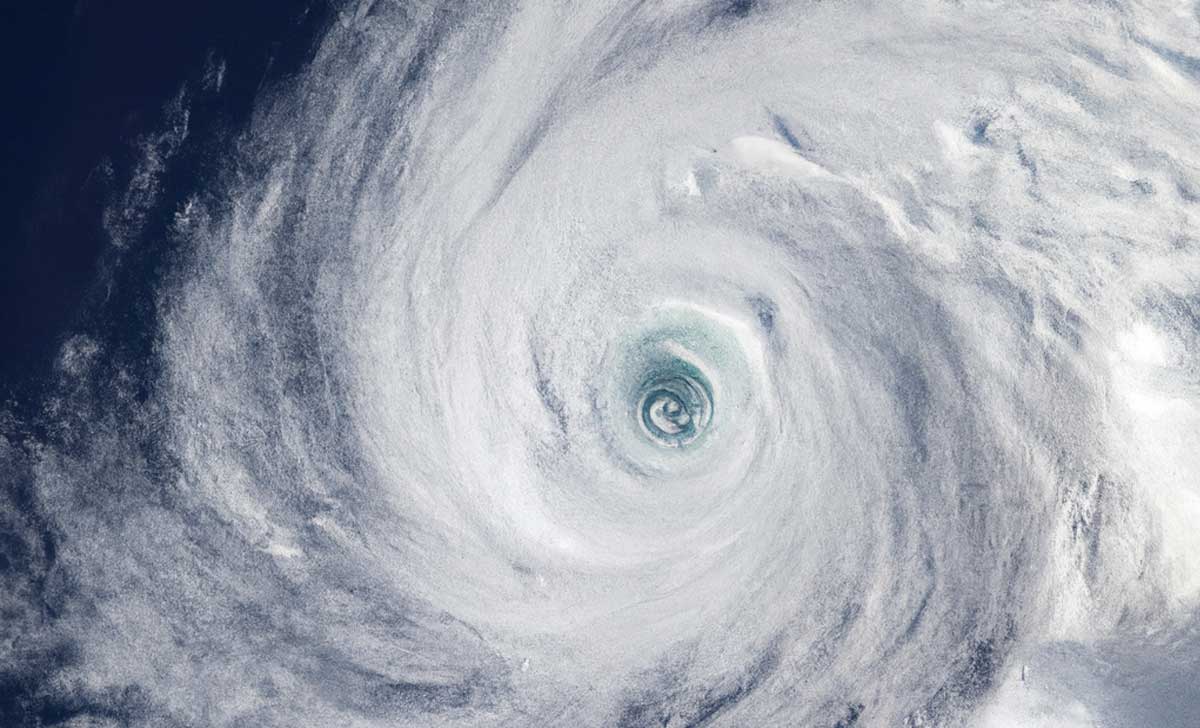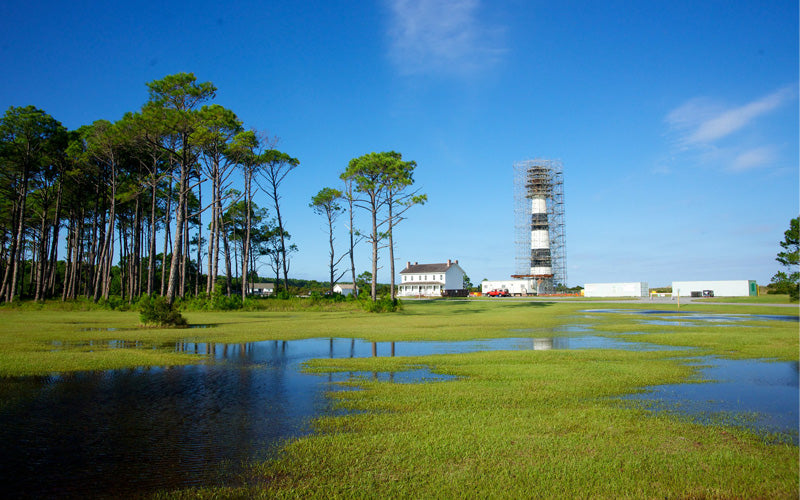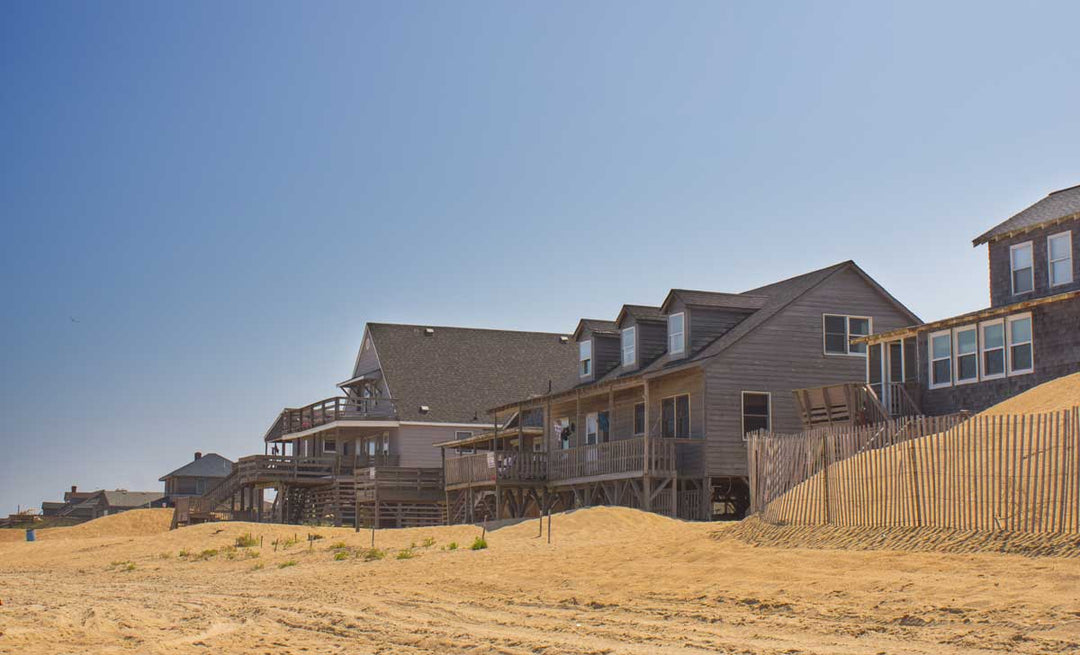History of Hurricanes Outer Banks North Carolina

The Outer Banks, a chain of barrier islands off the coast of North Carolina, can sometimes be both beautiful and treacherous. In the midst of a hurricane, these islands become a battleground between the forces of nature and human ingenuity.
The winds howl, the rain lashes down, and it feels like the very earth is shaking. Yet, there is a strange and awe-inspiring beauty in the chaos.
The hurricanes that strike the Outer Banks are among the most powerful and destructive in the world. They sweep in from the ocean, gathering strength and speed, and batter the fragile islands with wind and water. The beaches disappear beneath the waves, and the dunes are flattened. Houses are ripped from their foundations, and boats are tossed around like toys.
Although uncommon, hurricanes impact the coast of North Carolina occasionally during the Atlantic hurricane season.

Table of contents
- 1954 Hurricane Hazel
- 1955 Hurricane Ione
- 1958 Hurricane Helene
- 1960 Hurricane Donna
- 1962 Hurricane Alma
- 1963 Hurricane Ginny
- 1966 Hurricane Faith
- 1969 Hurricane Camille
- 1971 Hurricane Ginger
- 1972 Hurricane Agnes
- 1979 Hurricane David
- 1985 Hurricane Gloria
- 1996 Hurricane Bertha
- 1999 Hurricane Dennis and Hurricane Floyd
- 2003 Hurricane Isabel
- 2011 Hurricane Irene
- 2016 Hurricane Matthew
- 2018 Hurricane Florence
- 2019 Hurricane Dorian
Below is an extensive history of named Outer Banks and North Carolina hurricanes since the 1950s.
Note that this list only includes hurricanes that directly impacted the coast of North Carolina and not those that may have caused peripheral effects such as heavy rainfall or strong winds.
Hurricane Hazel (1954)
Hurricane Hazel was a Category 4 hurricane that made landfall near the North Carolina-South Carolina border in the early morning of October 15, 1954. It is considered one of the worst natural disasters in the history of North Carolina, with significant impacts on both the coast and inland areas.
The hurricane brought winds of over 100 mph and storm surge heights of up to 18 feet along the coast, causing extensive damage to homes, businesses, and infrastructure. Many coastal communities were utterly devastated, and over 15,000 homes were damaged or destroyed statewide. Hazel also caused widespread flooding and landslides in the mountainous regions of western North Carolina.
The storm was responsible for 19 deaths in North Carolina and caused over $136 million in damage (adjusted for inflation). In addition, the hurricane's impact led to significant changes in North Carolina's emergency management systems and coastal development policies.
Hazel's legacy continues to be felt in North Carolina, with many communities commemorating the storm's anniversary and taking steps to prepare for future hurricanes.
Hurricane Ione (1955)
Hurricane Ione struck North Carolina in August 1955 as a Category 3 hurricane with maximum sustained winds of 115 mph. The storm caused extensive damage to the state, particularly the coastal areas.
Strong winds and heavy rainfall from Hurricane Ione led to significant flooding in the eastern part of the state, evacuating thousands of residents from their homes. The flooding was particularly severe in low-lying areas near the coast, where the storm surge and heavy rains combined to cause significant damage.
In addition to the flooding, Hurricane Ione caused extensive damage to property and infrastructure. Many buildings were damaged or destroyed, and the flooding washed out roads and bridges. The hurricane also caused significant damage to the state's agricultural industry, particularly the tobacco crop.
Overall, Hurricane Ione caused more than $88 million in damages (in 1955 dollars) and resulted in 7 fatalities in North Carolina. The storm was a significant event in the state's history and prompted emergency response and infrastructure improvements to better prepare for future hurricanes.
Hurricane Helene (1958)
Hurricane Helene was a Category 3 hurricane that made landfall along the coast of North Carolina on September 27, 1958. The storm caused significant damage to the state's coastal communities, particularly in the Cape Fear region.
Hurricane Helene's strong winds and storm surge caused widespread flooding and damage to buildings, homes, and infrastructure. The storm surge, which was reported to have reached up to 12 feet in some areas, inundated many coastal communities and caused significant beach erosion.
In addition to the physical damage caused by the storm, Hurricane Helene also had significant economic impacts. The storm disrupted transportation and shipping along the coast, particularly in Wilmington and Morehead City ports. The storm also damaged crops and disrupted fishing and other coastal industries.
Overall, Hurricane Helene caused over $125 million (in 1958 dollars) in damages in North Carolina alone and resulted in 5 fatalities.
Hurricane Donna (1960)
Hurricane Donna was a powerful and destructive Atlantic hurricane that made landfall in North Carolina on September 11, 1960. It was a category 2 hurricane with sustained winds of 100 mph and gusted up to 120 mph at landfall.
The impact of Hurricane Donna on North Carolina was significant, with the storm causing widespread damage along the coast and inland areas. In addition, the storm surge associated with the hurricane caused extensive flooding in low-lying areas and caused severe beach erosion.
The winds from the hurricane downed trees and power lines, leading to widespread power outages and damage to buildings and homes. Many coastal communities were evacuated before the storm, and thousands of residents were left without homes or shelter after the hurricane passed.
In total, Hurricane Donna caused 7 deaths in North Carolina, resulting in over $387 million in damages (adjusted for inflation). It remains one of the most significant hurricanes to impact the state in modern times and serves as a reminder of the destructive power of these storms.
Hurricane Ginny (1963)
Hurricane Ginny, which occurred in 1963, was a Category 3 hurricane that made landfall near Wilmington, North Carolina. The cyclone caused significant damage to the coastal areas of North Carolina.
The hurricane brought strong winds up to 120 mph, uprooting trees and damaging buildings. In addition, the storm surge associated with the hurricane inundated low-lying areas along the coast, causing flooding and beach erosion. The combination of high winds and storm surges led to extensive damage to structures and infrastructure in the area.
In addition to the physical damage, Hurricane Ginny also caused significant economic losses in the region. The storm impacted agriculture, particularly tobacco and cotton crops, which were a significant source of income for the area. The damage to crops and infrastructure led to economic losses in the millions of dollars.
Overall, Hurricane Ginny was a powerful and damaging storm that had a significant impact on the coastal regions of North Carolina. In addition, the storm highlighted the need for improved infrastructure and planning to mitigate the effects of future hurricanes on the state.
Hurricane Faith (1966)
Hurricane Faith was a powerful and destructive Category 3 hurricane that impacted the coast of North Carolina in September 1966. The storm landed near Cape Fear and then moved northward along the coast, causing widespread damage along its path.
The storm surge from Hurricane Faith caused significant flooding along the coast, with water levels reaching as high as 10 feet in some areas. The strong winds associated with the hurricane also caused extensive damage, knocking down trees and power lines and causing widespread power outages.
In addition to the physical damage, Hurricane Faith significantly impacted the state's economy, particularly the fishing and tourism industries. The storm destroyed many boats and fishing equipment, and tourist areas along the coast suffered significant damage, leading to a decline in tourism after the hurricane.
Hurricane Faith was one of the most damaging storms to impact North Carolina in the 1960s, causing widespread devastation and significant economic losses.
Hurricane Camille (1969)
Hurricane Camille was a devastating Category 5 hurricane that struck the Gulf Coast of the United States in August 1969. Although North Carolina was not in the direct path of the storm, it did experience some impacts.
The storm produced heavy rainfall in North Carolina, particularly in the western part of the state, which resulted in significant flooding and landslides. At least 19 deaths were attributed to the storm in the state, and damage was estimated to be in the millions of dollars.
In addition to the flooding, Camille also generated high surf and dangerous rip currents along the North Carolina coast, which resulted in several drownings. In addition, the storm caused extensive beach erosion and damage to piers and other coastal infrastructure.
Overall, while North Carolina was not hit directly by the most severe impacts of Hurricane Camille, the storm still caused significant damage and loss of life.
Hurricane Ginger (1971)
Hurricane Ginger was a slow-moving storm that affected several areas along the eastern seaboard of the United States in September 1971, including North Carolina.
In North Carolina, Hurricane Ginger brought heavy rains, strong winds, and coastal flooding to the eastern part of the state. The storm caused significant damage to homes, businesses, and infrastructure, particularly in the coastal communities of Beaufort, Carteret, and Craven counties.
The heavy rainfall from Hurricane Ginger led to widespread flooding, which caused damage to crops, homes, and roads. The storm also caused significant erosion along the beaches and barrier islands, which affected the tourism industry in the region.
Overall, Hurricane Ginger caused significant damage and economic losses in North Carolina, with estimates of the total damage exceeding $11 million (in 1971 dollars). The storm serves as a reminder of the potential impact of hurricanes on the eastern coast of the United States and the importance of preparedness and planning for these events.
Hurricane Agnes (1972)
Hurricane Agnes landed in Florida in June 1972, but the storm caused significant damage and flooding in North Carolina as it moved up the East Coast. The storm brought heavy rainfall to the state, causing extensive flooding in several river basins. The Neuse River, in particular, experienced record-breaking flooding, and many communities along its banks were devastated.
Hurricane Agnes caused 22 deaths in North Carolina, and more than 7,000 homes were destroyed or severely damaged. The storm also damaged over 30,000 acres of crops and caused millions of dollars to damaged roads, bridges, and other infrastructure. The storm caused an estimated $120 million in damage in North Carolina.
The flooding from Hurricane Agnes was so severe that North Carolina declared a state of emergency, and the federal government declared several counties in the state disaster areas, making them eligible for federal assistance. The storm's impact was felt years after its passage, with many communities struggling to rebuild and recover from the damage.
Hurricane David (1979)
Hurricane David made landfall on the coast of North Carolina on September 5, 1979, as a Category 2 hurricane with sustained winds of 100 mph. The cyclone caused significant damage across the state, particularly in the eastern regions.
One of the most significant impacts of Hurricane David was the extensive flooding it caused. The storm brought heavy rainfall to many areas of the state, with some areas receiving up to 12 inches of rain in just 24 hours. The heavy rainfall caused numerous rivers to overflow their banks, leading to widespread flooding and damage to homes, businesses, and infrastructure.
The storm also caused significant wind damage, particularly in coastal areas. Many trees were uprooted or snapped, and power lines were downed, leaving tens of thousands of residents without power in the days following the storm.
Overall, Hurricane David caused at least $40 million in damage in North Carolina and resulted in six deaths. The storm was a powerful reminder of the destructive power of hurricanes and the need for preparedness and mitigation efforts to minimize the impacts of these types of events.
Hurricane Gloria (1985)
Hurricane Gloria was a powerful Category 4 hurricane formed in the eastern Atlantic Ocean in September 1985. While the storm did not land in North Carolina, it significantly impacted the state's coast.
As Hurricane Gloria approached the North Carolina coast, it produced strong winds and high surf that caused significant beach erosion and damaged coastal structures. In particular, the storm caused extensive damage to the beaches and beachfront homes in the Outer Banks area, including Hatteras Island and Ocracoke Island.
In addition to coastal damage, Hurricane Gloria also caused power outages for thousands of residents in eastern North Carolina, disrupting transportation and commerce in the region. While the storm did not cause significant loss of life in North Carolina, it did result in millions of dollars in property damage.
Overall, Hurricane Gloria's impact on North Carolina highlighted the vulnerability of the state's coastal communities to severe weather events and underscored the importance of disaster preparedness and emergency response efforts.
Hurricane Bertha (1996)
Hurricane Bertha made landfall in southeastern North Carolina on July 12, 1996, as a Category 2 hurricane with maximum sustained winds of 100 mph. The storm caused widespread damage along the coast, with storm surge flooding and beach erosion being the primary effects.
In North Carolina, Hurricane Bertha caused significant beach erosion, with some areas losing up to 50 feet of shoreline. In addition, the storm surge flooded streets, homes, and businesses in coastal towns such as Wrightsville Beach, Carolina Beach, and Surf City. As a result, many residents were forced to evacuate, and more than 220,000 people lost power.
In addition to the coastal impacts, Hurricane Bertha produced heavy rainfall across eastern North Carolina, flooding some areas. In addition, the storm caused significant agricultural damage, particularly to tobacco crops, which are an essential part of the state's economy.
Hurricane Bertha caused an estimated $270 million in damages in North Carolina alone. Fortunately, no fatalities were reported in the state due to the storm.
Hurricane Dennis (1999)
Hurricane Dennis landed in eastern North Carolina in September 1999 as a Category 2 hurricane. The storm caused significant damage in the region, with winds gusting up to 100 miles per hour and storm surge flooding coastal areas.
The hurricane caused widespread power outages, damaged buildings, and uprooted trees. In some areas, the storm surge reached 8 to 10 feet, causing significant flooding and erosion along the coastline.
The storm also produced heavy rainfall, with some areas receiving up to 10 inches of rain. This led to flash flooding and river flooding, particularly in the central and eastern parts of the state.
Overall, Hurricane Dennis caused an estimated $88 million in damages in North Carolina and was responsible for three deaths in the state. In addition, the storm serves as a reminder of the potential for significant impacts from hurricanes, even those not classified as major hurricanes.
Hurricane Floyd (1999)
Hurricane Floyd struck North Carolina in September 1999 and caused significant damage and widespread flooding. The storm resulted in at least 35 fatalities and generated an estimated $6 billion in damages.
Floyd produced heavy rainfall across much of the state, with some areas receiving up to 20 inches of rain over several days. The downpour led to severe flooding of many rivers and streams, including the Neuse, Tar, and Cape Fear Rivers. The floodwaters inundated many communities, resulting in evacuations and water rescues.
In addition to flooding, Hurricane Floyd caused significant wind damage in some areas. High winds knocked down trees and power lines, leaving hundreds of thousands of people without power.
Many homes and businesses were destroyed or severely damaged, and many communities struggled to rebuild. The storm also highlighted the need for improved disaster preparedness and response in the state, leading to emergency management policies and procedures changes.
Hurricane Isabel (2003)
Hurricane Isabel was a powerful Category 2 hurricane that made landfall near Drum Inlet, North Carolina, on September 18, 2003. The storm caused significant damage to many parts of the state, particularly in the eastern and central regions.
In the days following the storm's arrival, North Carolina residents were urged to evacuate low-lying areas and barrier islands along the coast. Many complied, but some chose to stay and weather the storm. Nevertheless, the hurricane brought strong winds, heavy rainfall, storm surge, and tornadoes, causing widespread power outages, flooding, and property damage.
The storm surge was particularly damaging, with waves reaching up to 8-10 feet in some areas. This caused significant flooding in coastal towns and cities, including Wilmington, New Bern, and Morehead City. The surge also caused substantial beach erosion along the Outer Banks, damaging homes and businesses and causing some areas to be removed entirely from the mainland.
Hurricane Isabel caused 33 deaths in the United States, with at least 16 occurring in North Carolina. The storm caused an estimated $3.6 billion in damage in the state, making it one of the most costly hurricanes in North Carolina's history.
Hurricane Irene (2011)
Hurricane Irene made landfall in eastern North Carolina on August 27, 2011, as a Category 1 hurricane with maximum sustained winds of 85 mph. Irene brought heavy rainfall, storm surge, and strong winds, significantly damaging the state.
The storm caused extensive flooding, particularly in low-lying areas and along rivers, with some regions experiencing record-breaking levels of rainfall. The flooding damaged homes, businesses, and infrastructure, including roads and bridges. In addition, many residents were evacuated from their homes due to the flooding.
In addition to flooding, Irene also caused significant wind damage, particularly in coastal areas. The storm knocked down trees and power lines, leaving hundreds of thousands of residents without power for days. The strong winds also caused damage to buildings and homes.
Overall, Hurricane Irene caused an estimated $1.2 billion in damages in North Carolina and was responsible for at least 8 deaths in the state. In addition, the storm served as a reminder of the significant impact that hurricanes can have on coastal communities and the importance of preparedness and response efforts.
Hurricane Matthew (2016)
Hurricane Matthew was a powerful Category 5 hurricane that caused significant damage and loss of life as it moved through the Caribbean and the southeastern United States in October 2016. In North Carolina, the hurricane made landfall as a Category 1 storm on October 8, 2016, bringing heavy rainfall, storm surge, and strong winds to the state.
The storm caused catastrophic flooding in many areas of eastern North Carolina, particularly in the cities of Fayetteville, Lumberton, and Princeville, which were hit hard by the storm. Thousands of people were forced to evacuate their homes as rivers overflowed their banks and floodwaters inundated communities.
Hurricane Matthew caused 26 deaths in North Carolina and an estimated $4.8 billion in damages, making it one of the costliest hurricanes in the state's history. The storm damaged or destroyed thousands of homes, businesses, and other structures and caused extensive damage to roads, bridges, and other infrastructure.
The impact of Hurricane Matthew was particularly devastating for low-income and marginalized communities in eastern North Carolina, many of whom were already struggling with poverty and lack of access to resources. The storm exacerbated existing social and economic inequalities, and the recovery effort in the years following the storm has been slow and difficult for many affected communities.
Hurricane Florence (2018)
Hurricane Florence made landfall in North Carolina on September 14, 2018, as a Category 1 hurricane with maximum sustained winds of 90 mph (150 km/h). The storm caused extensive damage to the state, including coastal areas and inland communities.
One of the immediate impacts of Hurricane Florence was flooding, as the storm dropped an enormous amount of rainfall, causing widespread river flooding and flash flooding. The flooding resulted in the closure of major highways, including I-40, I-95, and US-70, cutting off access to many towns and cities.
The storm also caused extensive wind damage, particularly near the coast where hurricane-force winds were felt. Tens of thousands of homes and businesses were damaged or destroyed, with some coastal communities being nearly leveled by the storm surge.
The hurricane had a significant impact on the agricultural sector in North Carolina, damaging crops, killing livestock, and destroying farms. The flooding also resulted in the release of hog waste and coal ash, leading to environmental concerns.
Overall, Hurricane Florence resulted in 51 direct fatalities in North Carolina, with many more people being displaced and suffering from the storm's effects for months afterward. In addition, it was one of the costliest hurricanes in North Carolina's history, with an estimated $17 billion in damage.
Hurricane Dorian (2019)
Hurricane Dorian, a powerful Category 5 storm, caused significant damage and flooding in North Carolina and landed along Cape Hatteras National Seashore on September 6, 2019. Although the storm's eye remained offshore, its outer bands brought strong winds, heavy rain, and storm surge to the state's coast.
The storm surge and heavy rainfall caused widespread flooding in low-lying areas and along the coast, leading to road closures and significant property damage. The flooding was particularly severe in the Outer Banks region, where some areas experienced over a foot of rain and record-breaking storm surge.
The high winds associated with the hurricane caused extensive damage to buildings, power lines, and trees throughout the state, resulting in hundreds of thousands of power outages. The storm also spawned several tornadoes, which caused additional damage to homes and businesses.
Hurricane Dorian caused at least 3 deaths and an estimated $1.7 billion in damage in North Carolina alone. The storm's impact was felt across the state, and the recovery effort took many months as communities worked to rebuild and repair the damage caused by the storm.
Conclusion
Despite the dangers, many people still choose to visit the Outer Banks during hurricane season. They come to witness the spectacle of nature at its most ferocious, and to test their own limits.






the ash wesnesday storm was a noreaster
Didn’t the Ash Wednesday storm breech the beach road and storm surge reach the bypass road in Nags Head?
I was surprised that Hurricane Fran in 1996 did not make your list. It was one of the most significant hurricanes to strike North Carolina and caused damage in central North Carolina that rivaled Hurricane Hazel.
Also, in 1989, Hurricane Hugo made landfall on the South Carolina coast but made a path to Charlotte. Hugo was expected to curve north into central North Carolina, but it surprised meteorologists by heading west and maintaining hurricane strength far inland. Hugo was to Charlotte what Fran was to Raleigh
I wouldn’t say many people choose to visit during that time because they want to but it’s the only time many can afford to visit. At least in my case lol
Leave a comment